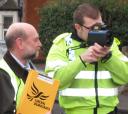Last Wednesday I attended a meeting of Tilehurst Globe which discussed improvements for School Road and the area around The Triangle. The meeting was addresed by Simon Beasley, the Traffic Manager at Reading BC. Afterwards we came up with the following proposals which were agreed unanimously.
Tilehurst Globe
TRAFFIC IMPROVEMENT: TILEHURST TRIANGLE
Tilehurst Globe welcomes the initiative to enhance pedestrian safety and improve the environment at Tilehurst Triangle. The Triangle is the shopping hub of Tilehurst Village and in addition to shops it also contains schools, the public library, banks, dentists and cafes. There is a history of traffic accidents with pedestrians in the Triangle and a petition has recently been presented by parents at Park Lane School asking for better pedestrian facilities.
Two other petitions have been presented to TMAP over recent years concerning the lack of a safe crossing over Westwood Road as it enters the Triangle.
The objectives of the changes are to:
1. Improve pedestrian safety.
2. Improve the environment for shoppers and traders.
Our proposals are as follows:
1. 20 mph zone from Park Lane School to the Norcot Road lights, including approximately 100 metres of Westwood Road, Corwen Rd and St Michaels Rd. The 20mph zone to be marked by road surface changes as well as signage.
2. New pedestrian crossing outside Jo-Jos Hairdressers.
3. Replace the current Pelican crossing at the chemist with a pedestrian crossing further north (towards the Norcot Road traffic lights) to better serve the pedestrian desire lines.
4. Railings at Dunstall Close and School Road up to the replacement pedestrian crossing above (to prevent illegal parking blocking School Road).
5. New pedestrian crossing 20 metres down Westwood Road from School Road.
6. New pedestrian crossing outside the Laurels/Public Library.
7. Mitigating measures against speeding through traffic in Westwood Road, Chapel Hill, Oak Tree Road and Overdown, including stopping pavement/verge parking and removing parking restrictions.
These proposals will help reduce traffic speed in the 20 mph zone along the stretch of School Road that includes the shops and schools. The impact of the new pedestrian crossings will be to slow drivers who would otherwise be tempted to put their foot on the pedal. By increasing the number of formal crossings and placing them at the desire lines, pedestrians will be encouraged to use safe crossings rather than attempting to cross the road in opposition to traffic and the pedestrian crossings will also address the needs of parents who have to make the journey between The Laurels and Park Lane Schools. The chief benefit of these changes is to improve pedestrian safety, but the reduction in speeds and the ease of road crossing will enhance the shopping experience. In addition, traffic delays will be reduced through replacing the Pelican by a pedestrian crossing, which require shorter traffic stops.
A key benefit for the schools will be the safer route between the two schools necessitating only one crossing (by JoJo’s).
These Triangle Proposals will impact a number of other roads, including Westwood, Oak Tree, Chapel Hill and Overdown Road, as through traffic may increase as some vehicles divert down these roads in order to avoid the Triangle. The measures of stopping pavement/verge parking and removing parking restrictions already proposed at TMAP will produce informal chicanes, and tend to control speeding. Mandatory chicanes and changes of road surface at specific danger points should be implemented in the future if there is negative impact of the changes in these roads or others in the area.
Potential Problems
In addition to many benefits that these proposals may bring it is fair to point out that the presence of so many zebra crossings over School Road may actually cause blockages of traffic along School Road and that by eliminating pavement parking along Westwood Road we may be causing problems for buses where cars are parked on both sides of the road.
Also, if the Triangle is seen as problematic for through traffic then drivers may well look for alternative routes (Oak Tree and Westwood roads for example) so these need to be considered.

